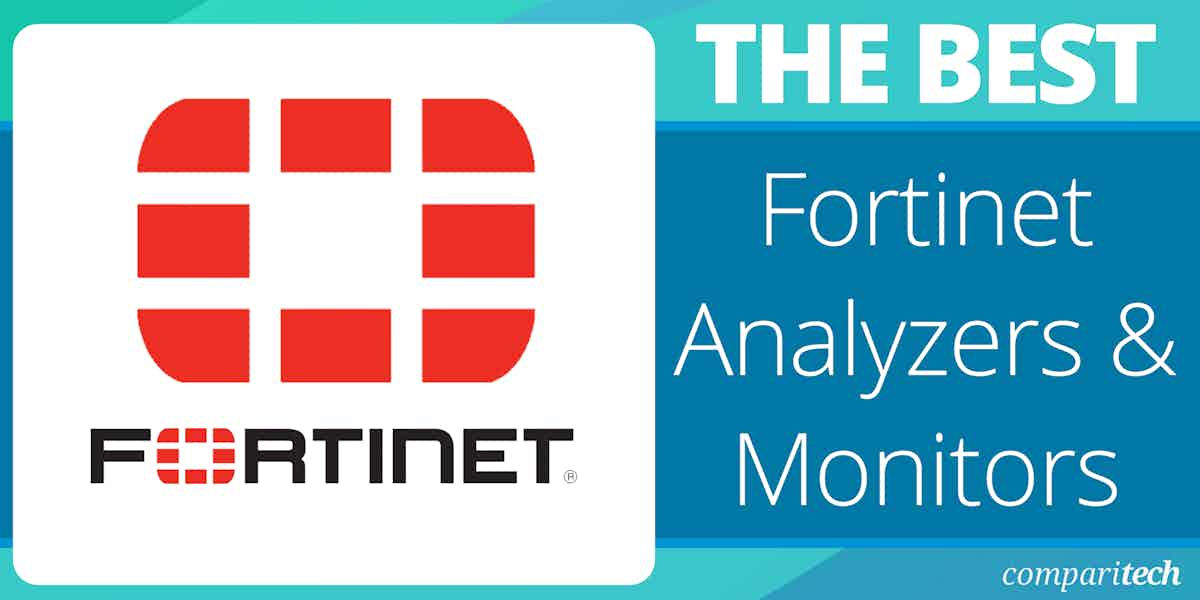Fortinet, a prominent American tech company, is known for its comprehensive cybersecurity products like firewalls, endpoint security systems, SASE, cloud security, intrusion detection systems, and more. However, like every software tool, Fortinet’s products also require regular monitoring to ensure they continue to stay up and running. Moreover, the data collected by monitoring these tools comes in handy to maximize the potential of these devices and to provide the best return on your investment. Specifically, Fortinet analyzers and monitors can address the following pain points in your organization:
- Lack of centralized visibility across all network security tools from Fortinet. This is a big issue when you use multiple tools from this company.
- Delays in threat identification and mitigation due to the unavailability of unified log data or analysis.
- Difficulty in tracking policy violations or configuration changes across different sites.
- Incomplete or non-availability of audit trails for compliance.
- Limited reporting capabilities.
To help mitigate the above pain points, this article covers in-depth reviews of the best Fortinet analyzers and monitors.
Here is our list of the best Fortinet analyzers:
- Paessler PRTG Network Monitor EDITOR’S CHOICE This on-premises package is able to gather live performance metrics from all network devices, including firewalls. The system can also watch activity on servers and trace application actions. This tool will provide Fortinet monitoring will simultaneously tracking the performance of all your other IT assets. Download the 30-day free trial.
- ManageEngine Firewall Log Analyzer (FREE TRIAL) A SIEM tool that installs on Windows Server or Linux. Download a 30-day free trial.
- Site24x7 (FREE TRIAL) A cloud-based infrastructure monitoring system that covers servers, networks, and applications. Start a 30-day free trial.
- Fastvue Reporter Monitors Fortinet FortiGate with graphical views on live data and produces a wide range of activity reports.
- LogicMonitor A cloud-based infrastructure monitor that can supervise Fortinet and FortiGate.
- Zenoss An online infrastructure monitoring system that can track events on any internet-connected network. Can be extended by a Fortigate plug-in.
- Zabbix A free open-source infrastructure monitoring system that can be tailored by “templates” to monitor Fortigate. Runs on Linux.
- Nagios Core and Nagios XI Free and paid version of this popular infrastructure monitoring system. The user community produces free extensions, including nine for Fortigate monitoring.
- Splunk A world-famous SIEM tool with an extension for Fortigate monitoring. Available in free and paid versions.
- Cyfin A log analyzer with specialist modules for monitoring Fortinet. Good for demonstrating compliance with HIPAA and CIPA.
If you need to know more, explore our vendor highlight section just below, or skip to our detailed vendor reviews.
Best Fortinet analyzers highlights
Top Feature
Performance tracking across devices using SNMP, NetFlow, and custom sensors
Price
Depends on the number of aspects, where an aspect is the metric tracked per device, starting $179 for 500 aspects
Target Market
IT teams and admins manage the configuration and performance of Fortinet products
Free Trial Length
30-day free trial
Additional Benefits:
- Tracks applications, servers, and network performance using SNMP and NetFlow
- Automatically identifies connected devices through auto-discovery
- Enables detailed security analysis through custom sensors like CPU and memory usage
- Issues notifications for detected issues to help maintain network integrity
Features:
- Uses SNMP, SNMP Traps, and NetFlow to monitor device performance
- Offers SaaS and Windows Server deployment options
- Supports advanced metrics with custom sensors such as latency, jitter, and session count
- Sends alerts when sensor values change or thresholds are breached
Top Feature
Centralized agentless log analysis and configuration monitoring for Fortinet firewalls
Price
Depends on the number of devices. The starting price is $395 for one device with two users
Target Market
Organizations that need complete visibility into their firewall policies and configurations
Free Trial Length
30-day free trial
Read more ▼
Top Feature
Cloud-based monitoring
Price
Starts at $9 per month and increases as you include more devices and add-ons
Target Market
IT teams that prefer cloud-based monitoring of their Fortinet devices
Free Trial Length
30-day free trial
Read more ▼
Top Feature
Advanced reporting and compliance for Fortinet FortiGate usage
Price
Negotiated price
Target Market
Organizations that need reports about the performance of Fortinet devices for tracking and compliance
Free Trial Length
14-day free trial
Read more ▼
Top Feature
Hybrid monitoring across cloud and on-premises Fortinet infrastructure
Price
Starts at $22 per resource per month
Target Market
Organizations that have Fortinet deployments across multiple sites
Free Trial Length
14-day free trial
Read more ▼
Top Feature
Unified observability across Fortinet and hybrid infrastructure
Price
Negotiated pricing based on device count
Target Market
IT teams that need full-scale monitoring for Fortinet devices across multiple locations
Free Trial Length
Demo available upon request
Read more ▼
Top Feature
Open-source monitoring with Fortinet compatibility
Price
Free
Target Market
Organizations seeking cost-effective monitoring for Fortinet products
Free Trial Length
Free software
Read more ▼
Top Feature
Custom plugins for Fortinet-specific monitoring tasks
Price
Nagios XI starts at $4,490 for 100 nodes
Target Market
Well-suited for enterprises that want to integrate Fortinet into their existing Nagios infrastructure
Free Trial Length
Free trial available
Read more ▼
Top Feature
FortiGate app for centralized Fortinet data visualization
Price
Negotiated price
Target Market
Security teams that want a centralized SIEM solution
Free Trial Length
14-day free trial (Splunk Cloud), 60-day free trial (Splunk Enterprise)
Read more ▼
Top Feature
Smart engine with AI-powered firewall data interpretation
Price
Negotiated pricing
Target Market
Organizations that need user behavior analytics and compliance reporting
Free Trial Length
Free trial available
Read more ▼
What is Fortinet?
Fortinet is a US company that produces cybersecurity systems. It started up in 2000 and is based in Sunnyvale, California. The company was founded by brothers Ken and Michael Xie and now, 21 years later, they are still in charge. By the end of 2019, the company had more than 6,000 employees and annual revenue of $2.16 billion.
The company’s main product is FortiGate, a firewall appliance. Recently, Fortinet has made a virtual appliance option available for FortiGate. Fortinet has been expanding the FortiGate family, creating FortiGate SD-WAN in 2018. More recently, the company has diversified out of the FortiGate product name with the release of FortiAI, a threat detection system that uses Artificial Intelligence in its detection processes.
What is Fortinet used for?
Fortinet’s products are all aimed at protecting networks and endpoints from cyberattack. The company markets its entire range as a “security fabric,” which is its proprietary term. It signifies a platform that offers a selection of modules that can all work together to improve security. This is a strategy that many other cybersecurity vendors now adopt.
What is a Fortinet Analyzer?
Fortinet produces an appliance, called FortiAnalyzer, that behaves like a SIEM system. It collects log data and feedback from other Fortinet appliances and systems. It then correlates this data in real-time, looking for threats.
SIEM systems are very common now – Fortinet isn’t the leader in the fields and it didn’t invent the strategy.
Many rival businesses produce systems that can analyze the log messages that Fortinet systems generate. Therefore, it is possible to buy an analyzer package that is able to receive logs from Fortinet devices along with the Event messages from Windows systems, Syslog messages from Linux hosts, and the log messages put out by a range of applications.
A log message server and consolidator that can retrieve, process, and analyze messages from Fortinet devices could be called a Fortinet analyzer.
Key Points to Consider Before Purchasing a Fortinet Analyzer
Choosing the right Fortinet analyzer is essential to gain complete visibility into your critical network security products. Below are the most important factors to keep in mind while evaluating different options:
- Compatibility: The first step is to determine if a tool is compatible with the different Fortinet devices in your network. Specifically, look for compatibility with the installed versions.
- Integration: The tool must integrate well with not just the Fortinet products, but also your overall tech stack.
- Real-time monitoring and alerts: The Fortinet analyzer must collect and analyze the data to provide alerts in real time, so you can address them quickly.
- Log retention: Pay close attention to this aspect because you’d want a tool that retains data for at least six months. This is important both from a compliance standpoint as well as to get meaningful analysis and comparisons.
- Simple interface: While selecting a tool, keep in mind the tech skills of different employers. They must be able to use this platform with minimal training.
- Reports: Give priority to tools that have templates for key compliance standards and out-of-the-box reports.
- Vendor support: Look for tools from vendors with a good history of customer support. Also, it’s important that the tool is updated regularly to meet the evolving changes.
How to Calculate the ROI of Fortinet Analyzers?
Besides the above-mentioned factors, cost is a key consideration. Instead of seeing only the expense side, make sure to take a holistic view to determine the return on your investment from a Fortinet analyzer.
We have come up with a structured way to calculate this ROI. Here are the steps.
Step 1: Estimate the Cost of Not Having a Fortinet Analyzer
As a first step, make a list of the costs that your organization is likely to pay when you don’t have a Fortinet analyzer. Some possible aspects can include:
- The average time taken to detect and respond to incidents.
- The number of hours lost by the IT team in manually reviewing logs and correlating them.
- Downtime from misconfigured alerts.
- Compliance audits and fines.
- The cost of using different monitoring devices.
Step 2: Cost of the Analyzer
Next, determine the cost of the Fortinet analyzer and its implementation. A few examples of costs to consider are:
- Licensing or subscription costs.
- Integration and setup costs.
- The costs involved in training users to use a tool.
- Time spent on setting up and configuring.
- Any maintenance or support fees.
Step 3: Potential Gains
In the next step, estimate the potential gains you will get by deploying a specific Fortinet monitor. Below is a list of the possible benefits:
- Lesser time to detect incidents and respond to them.
- Reduced downtime frequency.
- Lower software spending.
- Avoided audit penalties.
- Fewer misconfigurations and the resulting breaches.
Step 4: Put Them All Together
Finally, put all these numbers together and calculate the ROI with this formula:
- Annual savings = (Reduced Downtime * Revenue lost per hour) + (Reduced IT hours * Hourly rate) + Avoided compliance fines + Saved software costs + Any other savings
- Total investment is the items in step 2
- ROI = ((Annual savings – Total investment)/Total investment) * 100
The best Fortinet analyzers
1. Paessler PRTG Network Monitor (FREE TRIAL)
Best for: Performance tracking
Relevant for: IT teams and admins manage the configuration and performance of Fortinet products
Price: Depends on the number of aspects, where an aspect is the metric tracked per device, starting $179 for 500 aspects
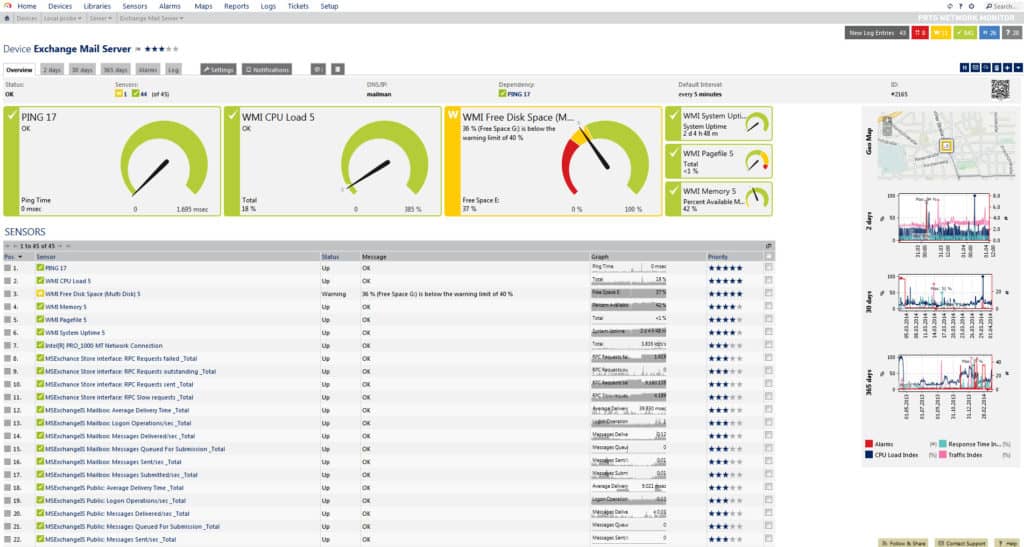
Paessler PRTG Network Monitor is a unified network monitoring solution that can monitor Fortinet devices. PRTG Network Monitor uses SNMP, SNMP Traps, and NetFlow collection to monitor the performance of connected devices. There is also an auto-discovery feature so that you can automatically discover connected devices.
Paessler PRTG Network Monitor’s Key Features:
- Comprehensive Monitoring: Tracks applications, servers, and network performance using SNMP and NetFlow.
- Auto-Discovery: Automatically identifies connected devices, simplifying setup.
- Custom Sensors: Enables detailed tracking of metrics like CPU usage and memory, enhancing security analysis.
- Alert System: Issues notifications for any detected issues, helping maintain network integrity.
- Versatile Deployment: Available both as SaaS and on-premises for flexibility in monitoring solutions.
Unique Business Proposition
PRTG has a unique sensor-based system, where you can select the sensors that you want to implement for monitoring specific Fortinet devices. Along with the flexibility, you can also combine information gathered through SNMP, NetFlow, and REST API to get a cohesive picture of your infrastructure.
Feature-in-Focus: Alert Triggers
A notable feature of PRTG is its alert triggers, which are sent to the configured team members when a Fortinet firewall goes into “conserve mode.” With this trigger, admins can act quickly to avoid major outages.
Comparitech SupportScore – 8.8
Paessler is a stable company with steady revenue. It is known for its self-supporting documentation and excellent customer service. Though its employee job satisfaction is slightly lower than average, there has been no impact so far. But that can change if the employee satisfaction levels continue to dip.
Why do we recommend it?
Paessler PRTG Network Monitor actually monitors applications and servers as well as networks. This tool provides monitoring for network devices, which includes Fortinet appliances. The system uses SNMP to check on device availability and performance and it can also collect NetFlow traffic data and Sylog messages from them.
Sensors like the SNMP Traffic Sensor and the SNMP System Uptime sensor collect performance data from devices. However, if you want to go more in-depth you can create custom sensors. Metrics you can track with custom sensors include Total CPU Usage, Session Count, Memory Usage, Total User (per CPU), User (time) Usage, State, Packets Sent/Received, Latency, and Jitter. The wide range of configurations allows you to identify a variety of attacks.
You don’t have to manually monitor these sensors to stay on top of security events. PRTG Network Monitor issues alerts as soon as a problem is identified. Alerts notify you whenever the status of a sensor changes, the value changes, or a predefined threshold has been breached.
Who is it recommended for?
Paessler PRTG is available as a cloud-based SaaS platform and also as a software package that can be downloaded onto Windows Server. If you only activate 100 of the monitors in the PRTG package, you never have to pay for the system.
Pros:
- Extensive Compatibility: Seamlessly integrates with Fortinet devices for efficient monitoring.
- Intuitive Interface: Features drag-and-drop report building and customizable dashboards for easy use.
- Diverse Monitoring: Employs a variety of methods including packet sniffing and WMI for comprehensive data collection.
- Freeware Version Available: Supports monitoring with up to 100 sensors for free, offering significant value.
Cons:
- Complex Setup: The platform’s breadth of features may require a steep learning curve for new users.
There is a free version of Paessler PRTG Network Monitor you can download if you want to monitor 100 sensors or less. The software starts at a price of $1,600 (£1,298) for 500 sensors and one installation and goes up to $14,500 (£11,767) for unlimited sensors. There is also a version with five server installations and unlimited sensors that costs $60,000 (£48,695). You can download the 30-day free trial.
EDITOR'S CHOICE
Paessler PRTG Network Monitor is our top pick for a Fortinet monitoring tool because it offers comprehensive functionality, ease of use, and seamless integration with Fortinet devices. PRTG excels in providing real-time visibility into network performance and security, making it an ideal choice for monitoring Fortinet firewalls, switches, and other Fortinet infrastructure components. One of the standout features of PRTG is its Fortinet-specific sensors, which allow administrators to monitor device health, bandwidth usage, and firewall activity with minimal configuration. These sensors can track metrics such as CPU and memory utilization, VPN connections, and threat statistics, ensuring you have a detailed understanding of how your Fortinet devices are performing. PRTG also supports SNMP, NetFlow, and other protocols, enabling it to collect and visualize data from Fortinet products efficiently. The user-friendly interface of PRTG simplifies complex monitoring tasks. Its customizable dashboards, intuitive alerts, and detailed reports make it easy for administrators to identify and respond to issues quickly, minimizing downtime and maintaining network security. Additionally, PRTG’s scalability ensures it can handle the monitoring needs of both small networks and large enterprises using Fortinet equipment. Another advantage of PRTG is its versatility. Beyond Fortinet, it can monitor devices from other vendors, making it a valuable tool for organizations with heterogeneous environments. Its robust alerting system, automation capabilities, and strong integration options with other IT management tools enhance its overall utility.
Download: Download a 30-day FREE Trial
Official Site: https://www.paessler.com/download/prtg-download?download=1
OS: Windows Server or SaaS
2. ManageEngine Firewall Log Analyzer (FREE TRIAL)
Best for: Log audits
Relevant for: Organizations that need complete visibility into their firewall policies and configurations
Price: Depends on the number of devices. The starting price is $395 for one device with two users
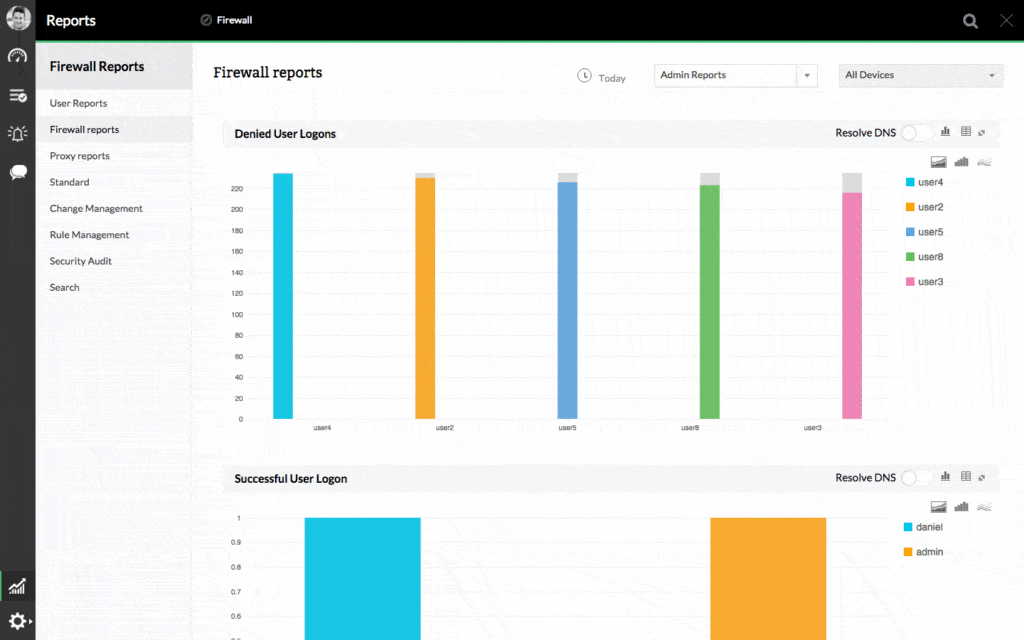
ManageEngine Firewall Log Analyzer is a log management tool that is compatible with Fortigate firewalls. ManageEngine Firewall Log Analyzer has a system log server that can take data from Fortinet devices in WELF or syslog format. Setting up the program to do this is simple but you do have to configure the firewall to send this information to the Syslog server first. Once you’ve done this you can take a closer look at the traffic entering the network.
ManageEngine Firewall Log Analyzer’s Key Features:
- Fortinet-Focused Monitoring: Tailored log management and analysis for Fortinet devices.
- Detailed Reporting: Offers a wide range of reports, enhancing security insights.
- Real-Time Analysis: Provides live data analysis for timely threat response.
Unique Business Proposition
This is an agentless and centralized log analysis and configuration management tool geared for Fortinet firewalls. Additionally, it supports multiple vendors, so no additional hardware or agents are needed for monitoring firewalls. It provides detailed information about the firewall rules, usage, bandwidth, security events, and compliance status.
Feature-in-Focus: Configuration Management
ManageEngine Firewall Log Analyzer continuously monitors existing policies and configurations to identify unused or redundant rules and track configuration changes. It also sends notifications in real-time to admins in case of any serious configuration changes.
Comparitech SupportScore – 9.3
This is a solid company backed by good revenue and customer support. It also has a large employee headcount and a reasonable employee job satisfaction score. Its self-supporting documents and resources are also excellent. All this means you can expect continued support quality from this vendor.
Why do we recommend it?
ManageEngine Firewall Log Analyzer creates a security monitoring service by gathering and searching through firewall log messages. Fortinet firewalls generate Syslog-format log messages and these will contribute to the source data of the ManageEngine tool. The system can write firewall rules back to the appliance to shut down detected threats.
There is an extensive reports function included with the program with many options compatible with Fortinet devices. Live Reports, Traffic Reports, Protocol Usage Reports, Web Usage Reports, Mail Usage Reports, Event Summary Reports, Firewall Rules Reports, and Attack reports are just some of the report types offered by the program.
Who is it recommended for?
This product will work with firewalls from all providers, not just Fortinet. The system is a software package that runs on Windows Server or Linux and you can also get it on AWS Marketplace. There is no free version of this tool but the Standard edition is accessibly priced.
Pros:
- Deployment Flexibility: Supports both on-premise and cloud-based setups to suit various business needs.
- Comprehensive Monitoring: Tracks critical metrics like memory usage and disk IO for a holistic network view.
- Auto-Discovery: Automatically identifies network assets, facilitating real-time asset management.
Cons:
- Feature Overload: The vast array of features may overwhelm new users, requiring time to fully leverage.
There are three versions of ManageEngine Firewall Log Analyzer available to purchase: Standard Edition, Professional Edition, and Enterprise Edition. The price starts at $395 (£320) with a maximum device count of 60 for the Standard Edition with support for one device.
The Professional Edition costs $595 (£482) for one device with a maximum count of 60 and firewall rule analysis and configuration analysis. The Enterprise edition costs $8,395 (£6,813) for 20 devices with a maximum device count of 1200. You can download the 30-day free trial.
3. Site24x7 (FREE TRIAL)
Best for: Cloud-based monitoring
Relevant for: IT teams that prefer cloud-based monitoring of their Fortinet devices
Price: Starts at $9 per month and increases as you include more devices and add-ons

Site24x7 is a SaaS-based central monitoring tool that can monitor Fortinet’s infrastructure. Site24x7 has a range of metrics for Monitoring Fortigate devices. The tool monitors big buffer hits, big buffer misses, buffer failures, CPU usage, CPU utilization, input packet drops, interface collisions, disk utilization, packets received, active session count, and more. You can monitor all of these metrics through the dashboard.
Site24x7’s Key Features:
- SaaS Monitoring: Offers cloud-based monitoring for various resources, including Fortinet infrastructure.
- Live Tracking: Enables real-time performance monitoring and historical data analysis for informed decisions.
Unique Business Proposition
This cloud-based monitoring solution supports the automatic discovery and monitoring of Fortinet devices through SNMP and NetFlow protocols. Also, its SaaS model reduces the need for additional hardware and speeds up deployment.
Feature-in-Focus: VPN Monitoring
Site24X7’s unique aspect is its comprehensive monitoring of Fortinet VPN devices. It measures the performance of these devices through metrics like the number of active SSL VPN users, uptime, data transfer rates and volumes, and more. It also offers visibility into IPSec, SSL, and VPN tunnels.
Comparitech SupportScore – 9.3
Site24X7 is known for its customer support, thanks to its large pool of technical and support staff. As a part of the same parent company as ManageEngine, Zoho Corporation, Site24X7 also shares the high-quality support staff with ManageEngine. Its revenue and self-supporting document are excellent as well.
Why do we recommend it?
Site24x7 is a SaaS platform that provides monitoring services for networks, served, middleware, applications, and websites. The tool’s network monitoring system includes device discovery and tracking, which can reach out to Fortinet appliances via SNMP. The package also includes a log manager to get Syslog messages from your Fortinet devices.
The software has an alerts system to keep you updated about the latest security events. There are instant notifications through email, SMS, voice, instant messenger, push notifications, RSS, and more. Alerts are configurable so you can set thresholds to revise notifications wherever you are.
Who is it recommended for?
This package is affordable for small businesses and large organizations can expand the base package’s capacity with extra fees. The tool provides full-stack observability with alerts for performance problems. That gives you instant root cause analysis when things go wrong.
Pros:
- Scalability: Designed for both small and large organizations with flexible pricing and add-ons.
- AI-Enhanced Analysis: Utilizes AI for root cause analysis, speeding up issue resolution.
- Comprehensive Views: Allows for application stack dependencies visualization, aiding in SLA optimization.
Cons:
- Learning Curve: The feature-rich platform may demand time to master all functionalities.
The Starter version of the Site24x7 Infrastructure package costs $9 (£7.30) per month. You can then purchase additional add-ons until you have what you need. The price is $15 (£12) a month for 10 additional servers, 50 servers for $50 (£40) a month, and 500 servers/websites $500 (£405). You can sign up for the 30-day free trial.
4. Fastvue Reporter
Best for: Advanced reporting and compliance
Relevant for: Organizations that need reports about the performance of Fortinet devices for tracking and compliance
Price: Negotiated price

Fastvue Reporter is a usage reporting tool for Fortinet FortiGate. Fastvue Reporter has a live dashboard that shows you the real-time performance of bandwidth, productivity, and protection. There are intelligent alerts so the user is notified when there is a problematic activity like unusually large downloads or a cyber attack.
Fastvue Reporter’s Key Features:
- FortiGate Reporting: Specializes in generating activity and security reports for Fortinet FortiGate.
- Intelligent Alerts: Minimizes false positives with smart alerting on notable activities.
Unique Business Proposition
Fastvue Reporter converts complex log data from different Fortinet devices into clear and actionable insights that can help executives make the right decisions. Its comprehensive dashboards and extensive reports make it a good choice for both technical and non-technical users.
Feature-in-Focus: Safeguarding Reports
A unique feature of this tool is its safeguarding reports. In conjunction with a firewall’s application control, it can monitor AI prompts on tools like Google Bard and ChatGPT. This feature is particularly useful for educational institutions that have strict policies against AI usage.
Why do we recommend it?
Fastvue Reporter is able to extract log data from Fortinet FortiGate and generate activity auditing reports. Fastvue also produces versions of the reporter to work with devices from other providers, including Barracuda, Cisco Systems, SonicWall, and Palo Alto. This system provides both performance and security monitoring as well.
As the name suggests, Fastvue Reporter’s number one feature is its reports. You can create and schedule reports for FortiGate routers. To make sure that the reports are sent to the right people you can filter by Departments, Security Groups, Offices, or Subnets. Report filters are useful for responding to threats and keeping the necessary individuals updated on what’s going on.
Activity Reports are also extremely useful for threat remediation. The reports include timestamps, URLs and green bars to show where browsing sessions stopped. Having this information readily available makes it much easier to investigate performance problems without having to wade through mountains of logs.
Who is it recommended for?
This is a very useful package for businesses that have only one firewall brand on site. As the Fortinet FortiGate system is a gateway device, this description covers a lot of businesses. Small businesses, companies that don’t use Fortinet FortiGate, and large businesses with a mix of firewall products on site should look elsewhere.
Pros:
- User-Friendly Reports: Simplifies performance and security monitoring with easy-to-understand reports.
- Focused Monitoring: Ideal for environments exclusively using Fortinet FortiGate.
Cons:
- Limited Scope: May not meet the needs of enterprises requiring extensive reporting capabilities.
To view a price for Fastvue Reporter you will have to request a quote directly from the company. The price depends on the number of users, length of a subscription term, and the number of FortiGates you need to monitor. You can download a free trial.
5. LogicMonitor
Best for: Growing organizations looking to scale their operations
Relevant for: Organizations that have Fortinet deployments across multiple sites
Price: Starts at $22 per resource per month
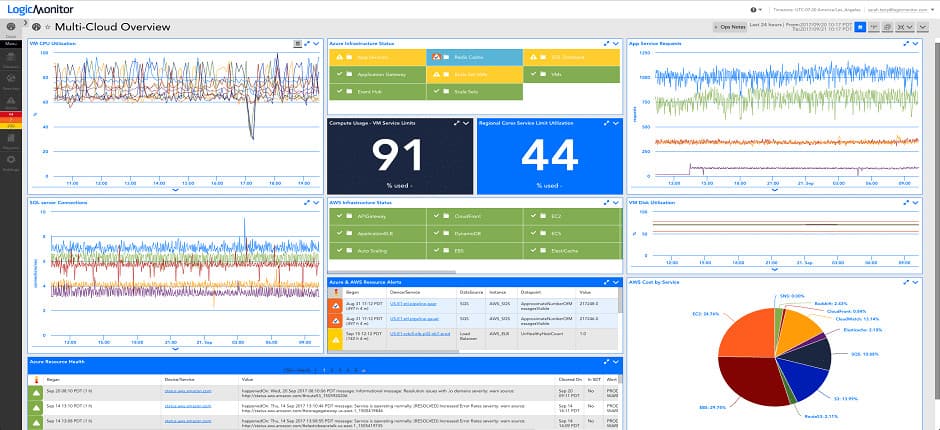
LogicMonitor is an infrastructure monitoring tool that is compatible with Fortinet and FortiGate. The platform offers automatic discovery, dashboards, and reporting to monitor IT infrastructure. The software is agentless making it easy to deploy in almost any environment.
LogicMonitor’s Key Features:
- Hybrid Monitoring: Efficiently monitors both cloud-based and on-premises Fortinet devices.
- Customizable Dashboards: Offers tailored views for different monitoring needs.
Unique Business Proposition
LogicMonitor uses SNMP and NetFlow protocols to gather and analyze data from multiple Fortinet devices like firewalls, VPN devices, switches, and more. With this analysis, it can provide detailed information on aspects like system health, network performance, security, and more.
Feature-in-Focus: LogicModules
LogicModules are templates that determine how LogicMonitor must collect and analyze data, and monitor the configuration and alert notifications as well. A highlight is that these modules are highly customizable and modular, and can be scaled up or down as needed, offering a ton of flexibility for organizations.
Comparitech SupportScore – 9.4
LogicMonitor is another company known for its high-quality customer support and well-developed documentation and resources. Its modest employee headcount and their reasonable job satisfaction scores mean that the company is on good footing, and we can expect continued support.
Why do we recommend it?
LogicMonitor is a cloud-based application monitoring package that uses AI to identify potential performance problems and identify their causes. A lower package of the system provides infrastructure monitoring without the upper function of application monitoring. This cheaper option includes live monitoring for network devices, which includes Fortinet firewalls.
There are a number of custom LogicModules that can be used with Fortinet devices. These modules allow you to monitor Fortigate firewall for Disk Usage, High-Availability mode, Module memory usage, Module sessions, Security Associations per module, Sensor Value, Current Sessions, Resource Usage, Threats, Peer CPU, HTTP Requests Blocked, HTTP Sessions Blocked, and HTTP URLs blocked.
Who is it recommended for?
This system is able to monitor firewalls on-premises or on the cloud, so whichever Fortinet configuration you went for, you can monitor it with this tool. Adding the application monitoring layer of the higher Enterprise edition gets you full-stack observability to identify how your firewalls fit into your entire delivery system.
Pros:
- Versatile Cloud Support: Suitable for assets across hybrid environments, enhancing flexibility.
- Customization: Allows for personalized dashboard setups, catering to individual or team preferences.
Cons:
- Short Trial Period: Only provides a 14-day trial, which may be insufficient for thorough evaluation.
There are three versions of LogicMonitor available to purchase under the Standard Pricing Model: Starter, Pro, and Enterprise. The Starter version starts at 50 devices, the Pro version at 100 devices, and the Enterprise version at 200 devices. You have to contact the sales team directly for a quote. There is also a 14-day free trial.
6. Zenoss
Best for: Unified observability
Relevant for: IT teams that need full-scale monitoring for Fortinet devices across multiple locations
Price: Negotiated pricing, based on the number of devices that need to be monitored
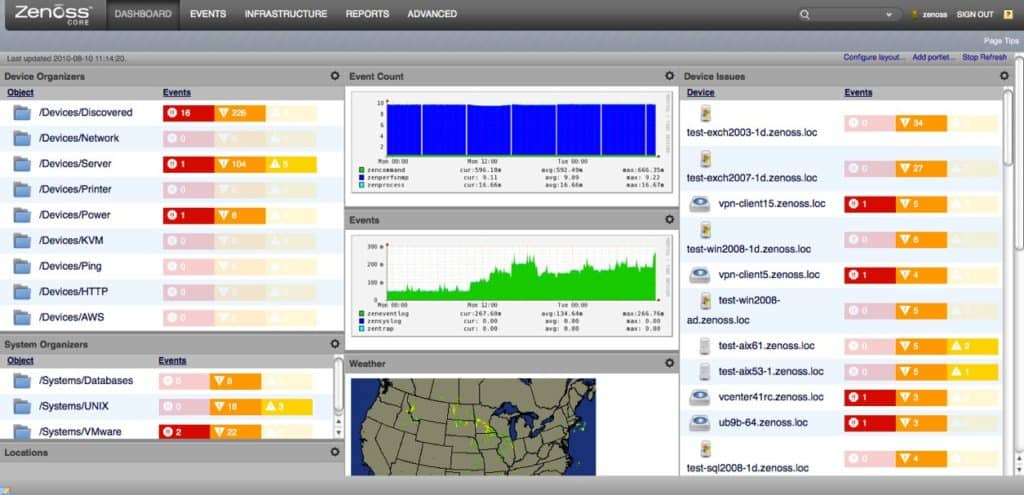
Zenoss is an infrastructure monitoring tool that’s available as a SaaS platform. From the dashboard, you can monitor the performance of IT systems and devices in your local environment (including Fortinet and FortiGate devices). The program also uses machine learning to identify unusual patterns and malicious behavior to reduce the impact of cyberattacks.
Zenoss’ Key Features:
- Plug-in Support: Offers specific plugins for detailed Fortinet device monitoring.
- Auto-Discovery: Automatically incorporates new network devices into monitoring.
Unique Business Proposition
Its extensible architecture makes Zenoss a flexible and convenient choice for organizations that have multiple Fortinet devices across their infrastructure. It seamlessly integrates with your tech stack, as well as these Fortinet devices. Such a unified approach makes it easy to identify issues and fix them quickly.
Feature-in-Focus: Zenpacks
ZenPacks is a unique feature that allows you to monitor anything in your infrastructure. You can pick from its pre-existing packages or build one to meet your specific requirements.
Why do we recommend it?
Zenoss provides network device monitoring, which includes Fortinet devices. This system is also able to track cloud services, so if you subscribe to one of the cloud-based products of Fortinet, you can also get full monitoring. It will even cover hybrid solutions with both on-site and cloud-based elements.
Zenoss has a number of plugins called ZenPacks. There is a ZenPack dedicated to Fortigate called Fortigate SNMP Monitor. Fortigate SNMP Monitor divides classes up into Network, Router, Firewall, and Fortigate. The user can monitor Fortigate firewall metrics such as CPU Usage, Memory Utilization, and Number of Sessions.
Who is it recommended for?
Zenoss has a free version, which has two names: Zenoss Core and Zenoss Community Edition. This has been officially discontinued. However, the last version, published in March 2022 is still available for download onto Windows, Linux, Unix, or macOS. The corporate edition is Zenoss Cloud – a SaaS package.
Pros:
- Broad Compatibility: Supports Cisco and Fortinet devices, among others, for comprehensive network monitoring.
Cons:
- Limited Support: Only offers technical support for paid versions, potentially limiting free users.
If you’re looking for a detailed and versatile infrastructure monitoring experience then Zenoss is ideal, particularly if you want to monitor Fortinet devices as well. To view the price, you will have to request a quote from the company directly. You can request a demo here.
7. Zabbix
Best for: Open-source monitoring
Relevant for: Organizations looking for a cost-effective way to monitor Fortinet products
Price: Free
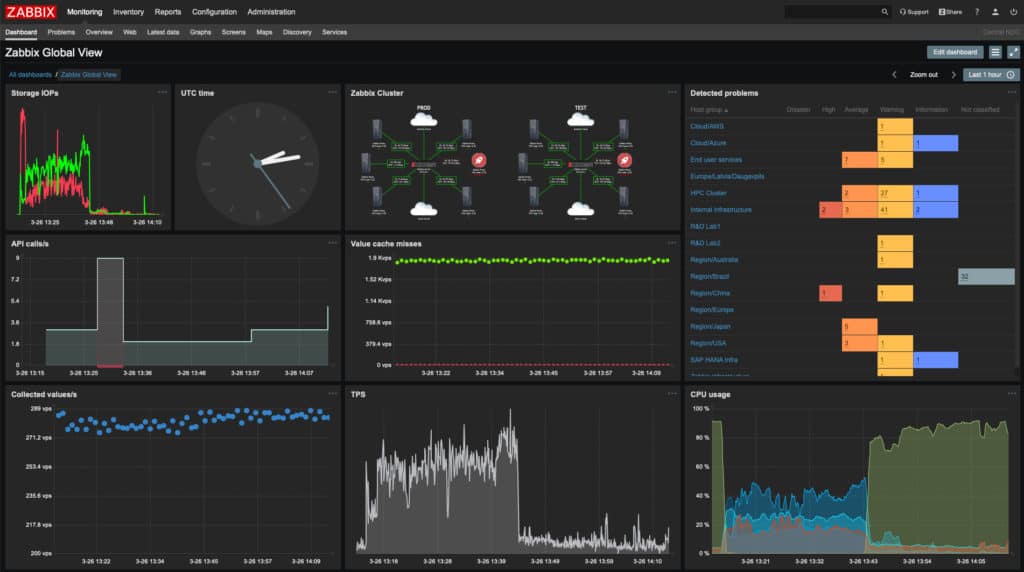
Zabbix is an open-source network monitoring, server monitoring, cloud-based service monitoring, application monitoring, and services monitoring platform. Zabbix is compatible with Fortinet devices and there are a number of Zabbix templates that are designed for Fortigate. One example is the Fortigate SNMP template.
Zabbix’s Key Features:
- Open-Source Monitoring: Provides a free platform with templates for Fortinet monitoring.
- Comprehensive Detection: Automatically identifies new devices and configuration changes.
Unique Business Proposition
Zabbix supports both SNMP and HTTP-based monitoring, making it a good choice for flexible deployment. Its dedicated templates and customizable dashboards are other aspects that make Zabbix valuable for organizations with a growing number of Fortinet devices.
Feature-in-Focus: Templates
A unique feature is its many templates that support different protocols. Also, it uses REST API to gather data from all devices for a unified view of your infrastructure’s status.
Comparitech SupportScore – 7.7
Though Zabbix has one of the highest employee job satisfaction scores on our list, its revenue and product diversification have been less than expected. Its employee headcount is also low, and it remains to be seen how the company will navigate these challenges in the coming years.
Why do we recommend it?
Zabbix has only one version and it is free to use – there is no paid version of this tool. It provides SNMP monitoring, which will track the performance of Fortinet on-site devices. It also communicates with on-site Fortinet devices through NetFlow and it can collect Syslog messages. The package also includes cloud monitoring.
The Fortigate SNMP template can monitor CPU%, RAM%, Disk (Total and Used), OS version, Serial Number, and Interface data (link and speed). These provide you with basic information to monitor SNMP data.
Who is it recommended for?
Zabbix will install on Linux. You can also run it on Docker or on a VM from Hyper-V, VMware, KVM, or VirtualBox. However, if you want it on the cloud, you can install the software on AWS, Azure., GCP, Oenshift, or Digital Ocean. Large businesses can subscribe to a professional support package.
Pros:
- Cost-Effective: Completely free tool, offering significant savings for businesses.
- Robust Alerts: Supports a wide range of notification methods for timely issue resolution.
Cons:
- Linux-Only: Availability restricted to Linux-based systems, excluding Windows environments.
The main advantage of Zabbix is that it is completely free. The tool is available for Red Hat Enterprise Linux, CentOs, Oracle Linux, Ubuntu, Debian, SUSE Linux Enterprise Server, and Raspbian. You can download Zabbix for free.
8. Nagios Core and Nagios XI
Best for: Customizable monitoring of Fortinet devices
Relevant for: Well-suited for enterprises that want to integrate Fortinet into their existing Nagios infrastructure
Price: Nagios XI starts at $4,490 for 100 nodes
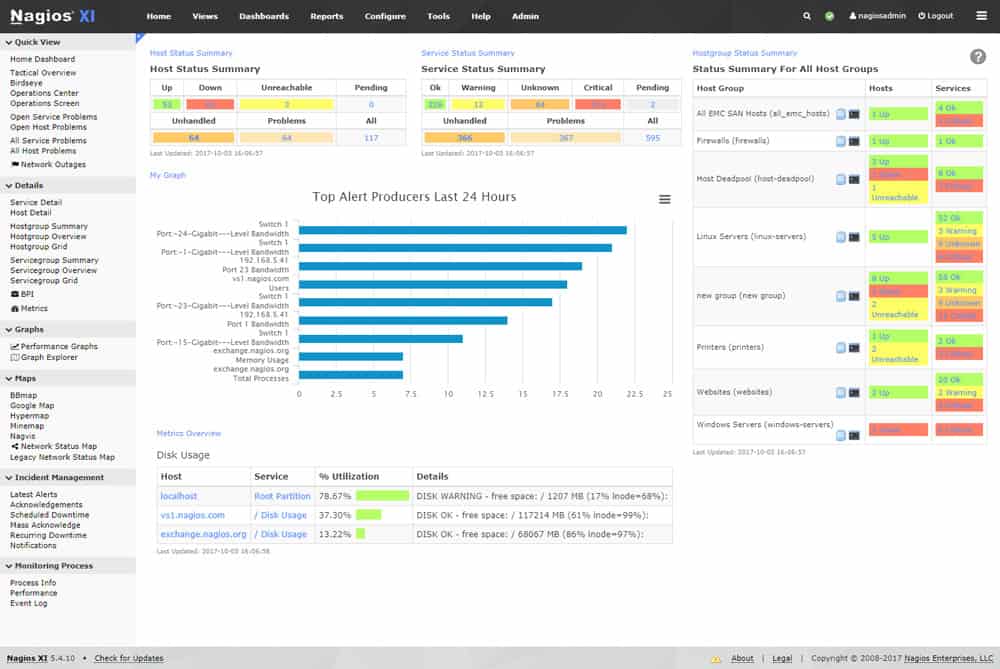
Nagios Core and Nagios XI are network monitoring platforms that can monitor Fortigate. Nagios Core is Nagios open-source product and Nagios XI is a proprietary product that you have to pay to use. However, both tools have access to the Nagios Exchange.
Nagios Core and Nagios XI’s Key Features:
- Flexible Versions: Offers both free (Core) and paid (XI) versions for varied business needs.
- Extensive Plugin Library: Features numerous extensions for customized Fortinet monitoring.
Unique Business Proposition
With Nagios, you can track critical metrics in real time. Some key metrics you can track are CPU usage, memory consumption, VPN status, hardware health, and more. This flexibility also supports integration with various Fortinet models and versions.
Feature-in-Focus: Custom Plugins
Nagios uses SNMP and custom plugins to gather data from Fortinet devices and analyze them for insights. It supports all SNMP protocols, making it compatible with even older Fortinet models.
Why do we recommend it?
Nagios Core and Nagios XI are free (core) and paid (XI) versions of the same tool. Both systems communicate with SNMP to track all network devices, including those of Fortinet. Unfortunately, the NetFlow capabilities and log management roles have been separated out into two paid packages.
The Nagios Exchange is a library of plugins that extend the basic features of the products. There are nine different plugins for Fortigate on Nagios exchange. These include Check Fortunate Active Sessions, Check Fortigate CPU l
Load, Check Fortigate CPU Usage, Check Fortigate Memory, Check Fortigate Status, and more.
Each plugin has different functions: the Check Fortunate CPU Load allows you to view the CPU load of your firewall and the Check Fortigate Hardware Health plugin lets you monitor the overall health of the device.
Who is it recommended for?
Small businesses will prefer the free, community-supported Nagios Core and larger businesses will go for the paid Nagios XI. If you want to collect log messages from your Fortinet devices, you will need to buy the Nagios Log Server and for NetFlow, you will need the Nagios Network Analyzer. Those tools don’t have free versions.
Pros:
- High Customizability: Provides detailed and adaptable dashboards through extensive plugin options.
- Discovery Features: Facilitates easy management of devices with autodiscovery.
Cons:
- Complex Features: The wide range of functionalities may require significant time to explore and utilize effectively.
Nagios Core and Nagios XI are good choices if you’re looking for cost-effective solutions for monitoring Fortinet devices. Paid versions of Nagios XI start at $1,995 (£1,618) for the Standard Edition and $3,495 (£2,836) for the Enterprise Edition. You can download the free trial version.
9. Splunk
Best for: Advanced log analytics
Relevant for: Security teams that want a centralized SIEM solution
Price: Negotiated

Splunk is one of the most famous network monitoring tools in the world. Splunk can take log and machine data from devices across your network and from Fortinet components. There is an extension built for Fortinet called Fortinet FortiGate App for Splunk. The app provides a real-time and historical analysis of traffic, threats, wireless ads, and more. Both Splunk and the add-on can be installed in a matter of minutes.
Splunk’s Key Features:
- Adaptable data analysis tool
- Analyzes log files
- Extension for Fortinet monitoring
Unique Business Proposition
A comprehensive platform for collecting, analyzing, and visualizing data from multiple Fortinet devices. Its many add-ons allow you to convert raw data into actionable insights, using which you can handle threat detection and compliance.
Feature-in-Focus: FortiGate App
A notable feature is the FortiGate app for Splunk that helps identify abnormal behaviors in your infrastructure. Moreover, it maps the data into Splunk’s intelligence framework to provide out-of-the-box insights.
Comparitech SupportScore – 9.5
Splunk’s strong approach to customer service, backed by well-developed documentation, has earned it a high score in our ratings. A large headcount, good product diversification, and excellent revenue are other high points of this company. Though the employee’s job satisfaction is a bit lower than what we would have liked, we don’t see any impact at all on the quality of customer service.
Why do we recommend it?
Splunk is a data analysis package that can process any data source. The company offers prewritten packages for performance and security monitoring. These can both collect data from Fortinet devices. You can set up the system to collect logs from your devices and it is also possible to feed in NetFlow and SNMP data.
The monitoring experience is led by the dashboard. From here you can monitor the performance and response times of your devices. The dashboard is customizable so you can choose which real-time and historic data you monitor.
Who is it recommended for?
There is no free edition of Splunk and the specialized monitoring add-ons can be quite expensive, so this isn’t a good choice for small businesses. The system is available for on-premises installation, called Splunk Enterprise, which runs on Linux, Unix, macOS, Windows, and Windows Server. There is a SaaS version, called Splunk Cloud.
Pros:
- Utilizes behavior analysis to detect threats that aren’t discovered through logs
- Excellent user interface, highly visual with easy customization options
- Enterprise-focused
- Available cross-platform for Linux and Windows
Cons:
- Caters more to enterprise networks than small to medium-sized organizations
Splunk Cloud service-supports unlimited users and unlimited data. So if you require more data than the free version you will have to contact the sales team directly to view a quote. You can download the free trial.
10. Cyfin
Best for: Web usage and visibility
Relevant for: A good choice for organizations that need user behavior analytics and compliance reporting
Price: Negotiated pricing
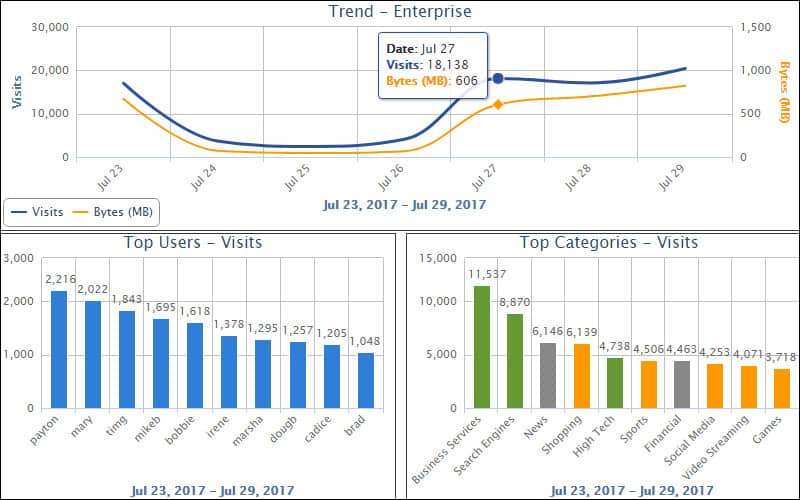
Cyfin is a log analyzer and web monitoring platform designed for Fortinet, Palo Alto, SonicWall, Check Point, WatchGuard, Cisco, and other device vendors. You can connect your Fortigate router to the Cyfin Syslog server to start monitoring your network. The Syslog server can monitor UDP-based and TCP-based log messages. Once the log files have been ported into the server you can view them in the Log File Viewer.
Cyfin’s Key Features:
- Log analyzer
- Special routines for examining network device activity
- AI-based analysis
Unique Business Proposition
Cyfin focuses largely on user behavior analytics, VPN monitoring, and web content filtering. Its advanced algorithms reduce data clutter and identify actual user clicks. Also, it supports different deployments and models, making it well-suited for organizations with a varied tech stack.
Feature-in-Focus: Smart Engine
A unique aspect of Cyfin is its smart engine processing that uses machine-learning algorithms and AI to convert complex firewall data into useful website-based information. It also comes with pre-built reporting for complying with many regulations.
Why do we recommend it?
Cyfin is an employee activity monitoring system that collects user activity data from network devices. This system analyzes network traffic rather than endpoint events or logs. This is a novel way to avoid employee sabotage of data collection agents. The service collects, manages, analyzers, and stores logs.
For general monitoring, the Smart engine analytics feature helps you to analyze the data you’ve collected. After collecting the data you can then generate reports for further analysis. Reports are also compliant with CIPA and HIPAA making the software suitable for auditing purposes.
Who is it recommended for?
The log management part of this system is useful for compliance auditing for PCI-DSS, HIPAA, GDPR, NIST, NERC CIP, and ECB. Deployment options include a SaaS package and VM-based on-premises installation over Hyper-V or VMware. This is a tool for large businesses that handle sensitive data.
Pros:
- Monitors both TCP and UDP traffic
- Leverages artificial intelligence for data analysis
- Offers compliance driven reporting (HIPAA, CIPA, etc)
Cons:
- Better suited for smaller networks
If you’re looking for a log analyzer that’s easy to use and configure quickly, Cyfin is high quality, although you will have to contact the sales team to request a quote. There is also a free trial version.
Choosing a Fortinet Analyzer
Fortinet devices and Fortigate routers are no different from any other device in your network. They need to be monitored and maintained to minimize the risk of a cyber attack.
Purchasing a solution that gives you the ability to measure these platforms is invaluable for catching security threats and minimizing damage to your network. Catching malicious traffic entering through your router could be the difference between staying online and being put out of business.
Tools like Paessler PRTG Network Monitor, Site24x7, ManageEngine Firewall Log Analyzer, and Splunk have support specifically for Fortinet devices. By hooking up a network monitoring tool to your Fortigate router you’ll be able to benefit from immediate notifications once a security event begins.
Our Methodology for Choosing a Fortiner Analyzer
We used the following factors to evaluate different Fortinet analyzers and to build our list of the best tools:
1. Ecosystem compatibility
We only looked for tools that are compatible with the entire Fortinet ecosystem, so the analyzer can work with any Fortinet product/version.
2. Log and event correlation
Since this is a key feature, we suggest only tools that can collect and correlate data from multiple sources. We also considered those tools that can detect patterns and identify misconfigurations.
3. Real-time capabilities
It’s important that a tool provides information in real-time, especially about misconfigurations or other potential threats.
4. Reporting
We prioritized tools that come with built-in reporting templates for meeting different compliance requirements.
5. Scalability
Another key consideration was scalability, as we want the tool to grow with your organization.
6. Vendor support and documentation
At Comparitech, we prefer to give weightage to those vendors with a good track record of customer support and excellent self-supporting documentation.
Based on the above factors, we selected the best Fortinet analyzers and monitors that can work well for your organization.
Broader B2B Software Selection Methodology
The above-discussed factors for choosing a Fortiner analyzer fit in with your broader methodology for recommending any B2B software. We review the features and test the tools where possible. These results are combined with user reviews and applicability across real-world scenarios. We also assess based on the following factors:
- Evaluation of the cost vs the value of the product.
- Track record of the vendor in customer support.
- Cybersecurity practices followed by the vendor.
- Transparency regarding the product’s capabilities.
- Financial stability.
- Available documentation and other self-supporting resources.
Click here for a more detailed explanation of our criteria.
Comparitech SupportScore Methodology
We use a proprietary SupportScore that measures the customer service offered by a vendor. On a weighted scale of 0 to 10, it tells you the past and current quality of support of the vendor, so you can decide if this is enough for your needs. Here are the key factors we consider while computing this score:
- Number of employees
- Job satisfaction of employees
- Availability of self-supporting documents and their quality
- Customer feedback and reviews
- Financial stability of the company
Read this for a detailed look at our SupportScore.
Why Trust Us?
At Comparitech, our goal is to provide unbiased reviews of every product to help you select the one that best meets your needs. We essentially put ourselves in your shoes and do the required background work, including testing, analyzing, and reviewing data, to provide the most relevant information for you.
Fortinet Analyzer FAQs
What is Fortinet analyzer?
Fortinet devices are network appliances and their performance can be analyzed with a standard network monitor. Network monitors use the Simple Network Management Protocol (SNMP) to track the statuses of network devices and Fortinet equipment is shipped with SNMP agents loaded onto them. There is also a system available from Fortinet that is called FortiAnalyzer, this is a SIEM system that collects and analyzes log messages.
What is the use of Fortinet?
Fortinet provides network security. While, traditionally, the company only delivered physical equipment with firewall software loaded onto it, Fortinet has now diversified and offers virtual appliances and SaaS cloud services as well.
What is packet flow in FortiGate firewall?
The FortiGate appliance is a security system delivered on a network device. All packets on the network travel through the appliance and the count of packets entering the device (ingress) and packets leaving the device (egress) constitute the packet flow.

